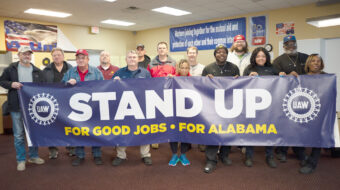
Build the fight for jobs – Part 2
Second in a series of three articles
Rick Nagin also co-authored this series.
The struggle for jobs and relief, spearheaded by a broad labor-led coalition, must take on corporate economic ideology. In particular, it must address the dual political paradigm of privatization/market supremacy – downgrading everything public, and “supply side” economics, meaning the more money is accumulated at the top, the more will then paternalistically “trickle down” to the working class in the form of jobs and benefits.
These two ideological points are closely tied together, two sides of the same class coin. Both are conceptual products of the “Reagan revolution” of the 1980s. They represent a complete reversal of the previous model of New Deal “bottom up” economics. When President Franklin Delano Roosevelt and Congress, with the help of a huge labor/people’s movement, passed Social Security, the Wagner Act, unemployment compensation, the progressive income tax and the public works programs of the New Deal, a new view of economics was put in place, recognizing that the working class must have power to buy goods and services and that the government had the responsibility to make that happen.
The movements that emerged from the Great Depression of the 1930s were fueled by intense anger at the massive accumulation of wealth at the top and the impoverishment of working people. The Depression was the result of this massive redistribution of wealth upwards, from the working and middle classes to the capitalist ruling class. The late 1920s saw the widest disparity in wealth between rich and poor ever seen – that is, until the present.
The redistribution of wealth upward in the recent period has resulted in the widest gap in wealth between classes in history. In the 1970s the average CEO made 12 times the income of the average worker. Today the ratio is over 300 to one. This reflects the widest gap between classes anywhere in the developed world.
This massive impoverishment of working people has reduced the buying power of all but the wealthiest in our society and, consequently, has wiped out “the market” for goods and services produced. When workers don’t have money, they can’t buy anything. The result is layoffs, cuts in wages and benefits and the entire economy grinds to a complete halt! That is where we are now.
Unfortunately, the “supply side” economic model continues to have too much clout. The bank bailout, much of the stimulus money, even the proposal for a “jobs package,” have funneled or propose to funnel federal funds to the top, to the bankers, contractors and capitalists, in order to “stabilize the economy” and “create jobs.” While certainly some jobs have emerged, the programs so far are limited and the results are very difficult to quantify. The jobs are often untargeted, temporary or part-time, lacking in benefits as well as affirmative action, safety, prevailing wage and labor law guarantees, and have insufficient oversight, opening the door to corruption.
The current outlook of the business community was bluntly stated by William J. Dennis of the National Federation of Independent Business, in a front page New York Times article Dec. 21: “When a job comes open now, we fill it with a temp, extend a part-timer’s hours, or bring in a freelancer, and then wait to see what happens.”
This is hardly a solution to the crisis. It only gives more reason to believe that the great bulk of the stimulus funds has ended up in the pockets of contractors, not workers. The end result of both the bailout and stimulus programs is that massive sums of public dollars have gone to the very class of individuals that created the disparity in wealth and, thus, the economic depression. That is why unemployment continues at double-digit levels and anger on the part of working people is growing. They don’t see the promised jobs or income, and resentment is epidemic at the giveaway of federal dollars to billionaires.
“There are those who choose not to speak about African Americans or the working class,” Rep. Maxine Waters stated on behalf of the Congresssional Black Caucus in December. But, she added, “we can no longer afford for our public policy to be defined by the worldview of Wall Street.”
A new model – a must!
In order to sink roots among working families, and to address the massive economic crisis, the labor-led movement needs to recognize and take on this ideological issue and develop a new, bottom up, economic model. We need to fight for direct payments of federal dollars to distressed working class communities, families and individuals through central administrative agencies to guarantee oversight and compliance with labor, civil rights and health and safety regulations. Only in this way will working people see the creation of family-supporting jobs and will federal spending result in creation of a market for goods and services produced in our nation.
The creation of a new industry based on green energy will take a huge targeted, federally owned, public jobs program. While there are some, generally small, businesses geared to make green energy products, this has not been an area where capitalists have been able to make massive profits, and thus, capital continues to be concentrated in old polluting energy industries. It will take direct federal spending and a publicly run program to assure that this new industry can emerge and help save our planet, as well as our economy.
Similarly, it will take direct federal intervention to meet the $2.2 trillion deficit in the existing infrastructure of bridges, dams, water, sewer and electric systems, parks, roads and mass transit, and to retool the auto industry for mass transportation, green energy and fuel efficiency. Only the federal government can address these needs, which will create millions of jobs and get the economy moving.
The ideological side-effects of a successful fight on this issue can help produce a pro-union culture, recognizing that the more workers make, the better the overall economy will be. This fosters understanding that when companies cut workers’ pensions and benefits, everyone’s living standards decline. This fight pushes us in the direction of a solidarity society, where workers understand that their personal well-being is directly tied to the well-being of their entire class.
Tied to a militant labor-led people’s movement for jobs and relief, the ideological struggle can help create the political space for the movement to push towards a broader program for the progressive changes that our society so badly needs.
Part 1 of this series: Jobs for America Now can be catalyst for mass action
Part 3: Challenging anti-government ideas
Photo: High schoolers learn job and safety skills in a union-city program in Philadelphia. PW/Ben Sears

MOST POPULAR TODAY

High Court essentially bans demonstrations, freedom of assembly in Deep South

Zionist organizations leading campaign to stop ceasefire resolutions in D.C. area

UN warns that Israel is still blocking humanitarian aid to Gaza

U.S. imperialism’s ‘ironclad’ support for Israel increases fascist danger at home








Comments